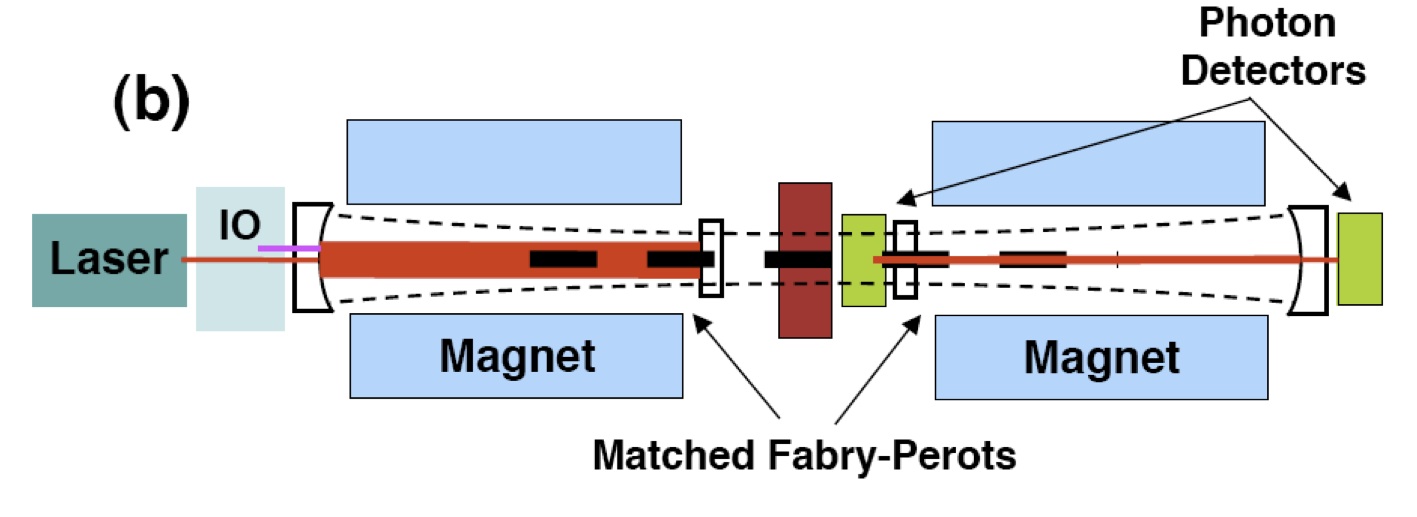Projects: GammeV Resonantly Enhance Axion Photon Regeneration (GammeV – ReapR)
 The Resonantly Enhanced Axion Photon Regeneration (REAPR) experiment will search for new axion-like scalar particles with ultraweak couplings to photons. These particles, also known as pseudo-Nambu-Goldstone bosons, are predicted in generic string theory models, and observations of astrophysical gamma rays already hint at their existence. REAPR is a photon-axion oscillation experiment. An intense laser beam is sent into a strong magnetic field generated by accelerator magnets, where laser photons can slowly convert into new, weakly-interacting axions. The vast majority of laser photons do not convert, and a beam blocker is placed after the magnets to stop the photon beam. However, a tiny stream of newly created axions can pass through the beam blocker. To detect the axion beam, a second magnetic field is used to convert it back into a beam of photons. Th
The Resonantly Enhanced Axion Photon Regeneration (REAPR) experiment will search for new axion-like scalar particles with ultraweak couplings to photons. These particles, also known as pseudo-Nambu-Goldstone bosons, are predicted in generic string theory models, and observations of astrophysical gamma rays already hint at their existence. REAPR is a photon-axion oscillation experiment. An intense laser beam is sent into a strong magnetic field generated by accelerator magnets, where laser photons can slowly convert into new, weakly-interacting axions. The vast majority of laser photons do not convert, and a beam blocker is placed after the magnets to stop the photon beam. However, a tiny stream of newly created axions can pass through the beam blocker. To detect the axion beam, a second magnetic field is used to convert it back into a beam of photons. Th
e regenerated photons which have apparently gone right through the blocker can be counted with quantum-limited, low noise photon detectors.
To enhance the conversion and regeneration rates, a pair of Fabry-Perot optical cavities are placed around the axion generation magnet and the photon regeneration magnet. The first cavity serves two purposes — to recycle the initial photon beam by passing it back and forth through the magnetic field many times, and to shape the spatial profile of the beam. For low axion mass, the generated axion beam inherits the spatial profile of the initial photon beam. The length of the second cavity as well as the curvature of its mirrors are matched to the incoming axion beam, and so regenerated photons can be efficiently trapped in this cavity, and the standing wave amplitude of trapped photons builds up coherently. The combination of beam recycling and coherent trapping results in large enhancement factors (approaching ten billion) to the detection rate of regenerated photons. The process can be alternatively viewed as the measurement of the spring constant of an ultraweak spring connecting two high-Q oscillators. If the oscillators are tuned to have the same resonant frequency, then power injected into one oscillator can more efficiently leak into the other oscillator.
With the combination of resonant enhancement of the conversion rate, and long strings of accelerator magnets, REAPR will be the most sensitive laser axion search ever conducted, and probe physics at the 10^11 GeV scale.
Team Members
- Aaron Chou









